Key takeaways:
- Creativity in development is a dynamic process enhanced by collaboration and diverse perspectives.
- Embracing techniques like rapid prototyping and brainstorming sessions can significantly boost creativity.
- Creating a conducive environment, minimizing distractions, and integrating playful elements are crucial for fostering inspiration.
- Personal experiences, such as stepping away from coding or adopting a “no bad ideas” policy, can lead to unexpected breakthroughs in creative projects.
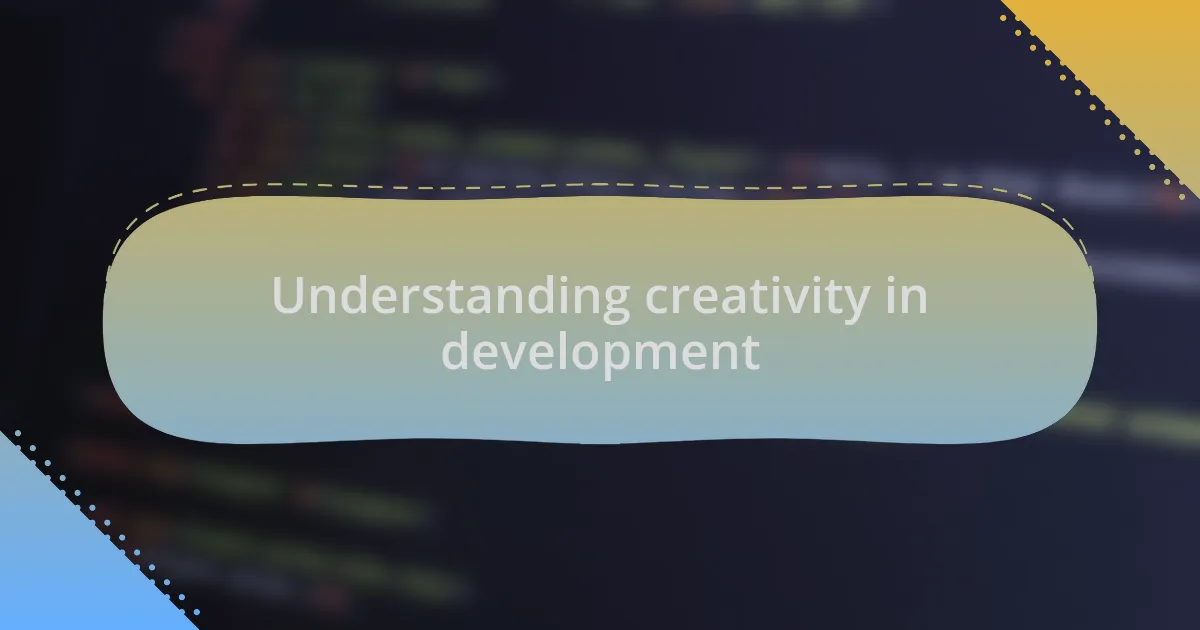
Understanding creativity in development
Creativity in development often goes beyond mere problem-solving; it’s about envisioning new possibilities. I recall a project where I had to build a unique feature under tight constraints. Instead of feeling limited, I embraced the challenge, allowing fresh ideas to emerge, which ultimately led to a more innovative solution. Isn’t it fascinating how restrictions can sometimes fuel creativity?
When I think about creativity, I often reflect on moments of inspiration that strike unexpectedly, like a lightning bolt. For instance, while debugging a complex piece of code, I once discovered a simpler approach that not only solved the problem but enhanced overall functionality. It made me realize that creativity is less about lightning strikes and more about nurturing an ongoing dialogue with our work.
Understanding creativity in development means recognizing it as a dynamic process. I’ve learned that collaboration can significantly enhance this process. During a team brainstorming session, sharing ideas sparked an avalanche of creativity, transforming our project’s direction. Have you ever experienced that moment when a single idea from a teammate suddenly opens a floodgate of inspiration? That’s the magic of collective creativity, and it’s something I cherish in my development journey.
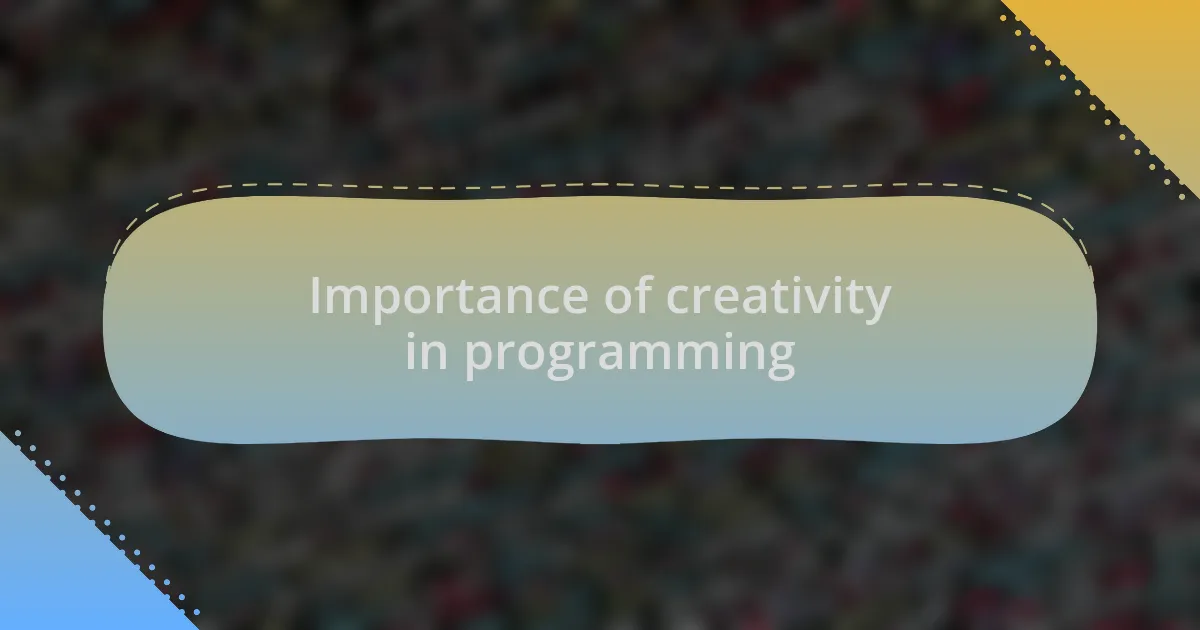
Importance of creativity in programming
The role of creativity in programming cannot be overstated. It’s what allows software engineers to innovate and adapt in a constantly evolving tech landscape. I’ve often found that when I tap into my creative side, it opens the door to unique solutions that wouldn’t emerge from a strictly logical approach. Have you ever faced a coding challenge that seemed insurmountable, only to find a creative workaround that felt almost like magic?
Creativity fuels the development of user-friendly interfaces and engaging functionalities. I recall an instance when I was redesigning an app interface. Rather than adhering rigidly to standard conventions, I decided to experiment with unconventional layouts. The result was not just visually appealing but also enhanced user interaction in ways I had never anticipated. It’s moments like these that reinforce my belief that creativity is integral in making technology more accessible and enjoyable for everyone.
Moreover, integrating creativity into programming fosters a sense of fulfillment and passion in what we do. There have been times when I felt stuck in a monotonous coding cycle, but shifting my mindset to view problems as opportunities for innovation reignited my enthusiasm. Isn’t it intriguing how allowing creativity to flourish can transform our work from routine tasks into engaging projects we genuinely enjoy?
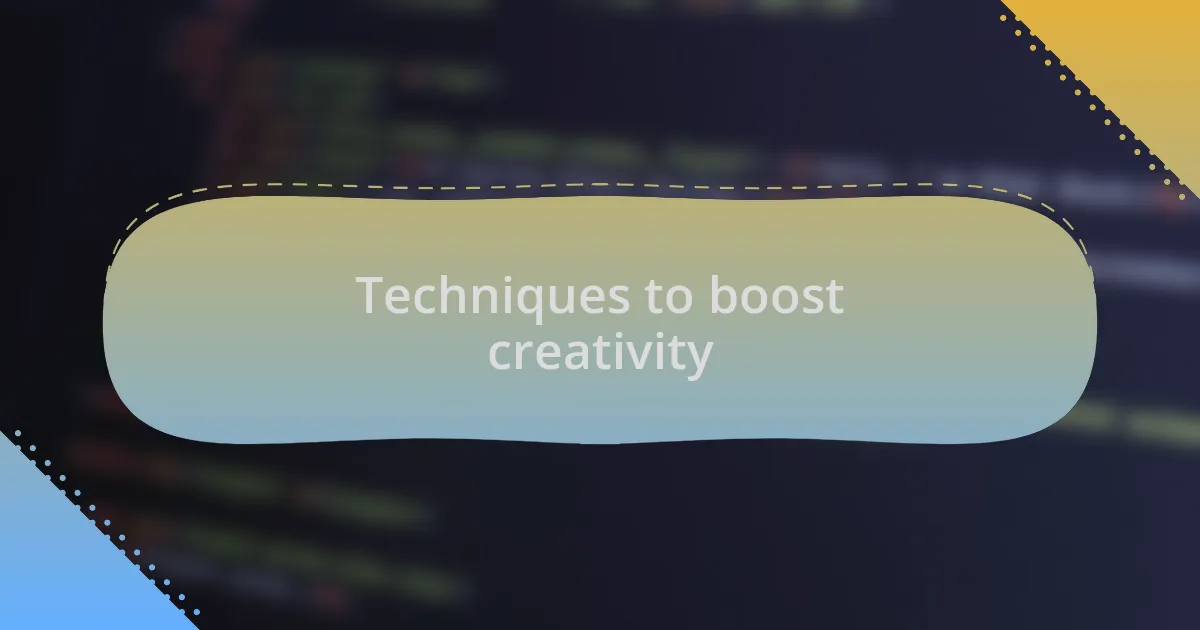
Techniques to boost creativity
One effective technique to boost creativity is to embrace rapid prototyping, which allows you to explore ideas without the pressure of perfection. I once spent a weekend building a sketch of a new software feature, not worrying about the code’s quality. Just watching the concept evolve on the screen sparked a flurry of additional ideas. Have you ever tried sketching out your thoughts? It can be liberating.
Diversifying your input sources is another powerful way to cultivate creativity. I often find inspiration in unexpected places, like art exhibits or even unrelated fields like biology. One time, a visit to a local gallery made me see color combinations differently, which I later applied to a user interface project. How often do we limit ourselves by sticking only to coding forums or tech blogs? Seeking varied perspectives can lead to innovative solutions you might not have initially considered.
Lastly, implementing brainstorming sessions with peers can yield remarkable results. I remember collaborating with a group where we tossed around wild ideas, free from the usual constraints of everyday tasks. The result was a mind map filled with possibilities that pushed boundaries we hadn’t even considered before. Have you experienced the magic of a collaborative environment? It’s often in those moments we discover that collective creativity can result in something truly extraordinary.
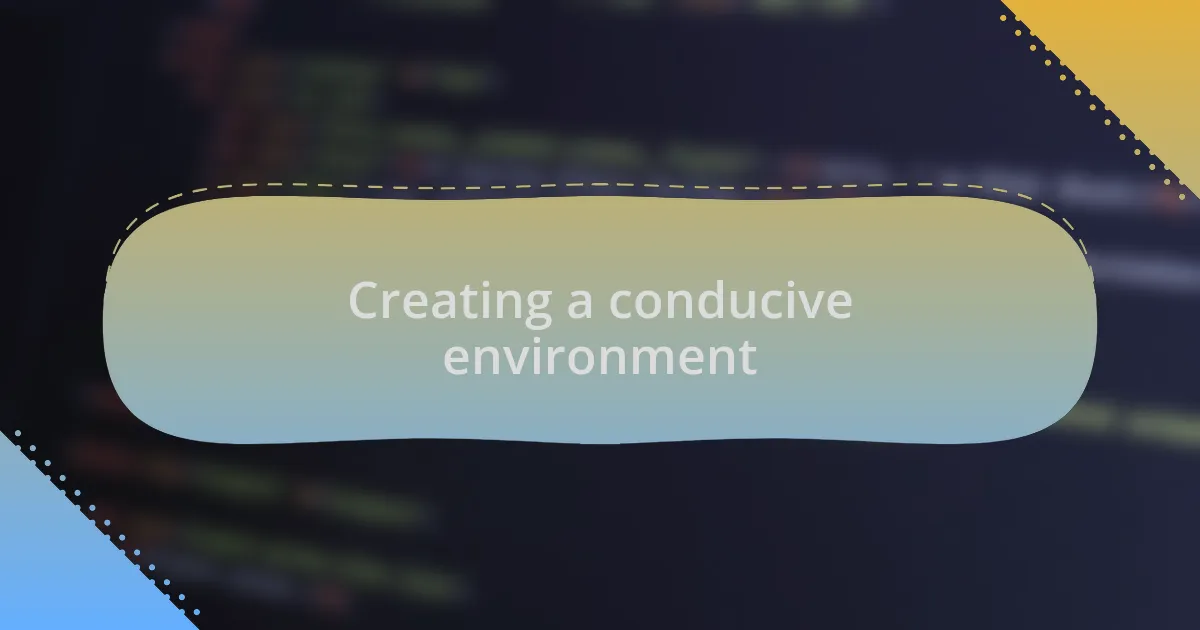
Creating a conducive environment
Creating a conducive environment for creativity hinges on the atmosphere we cultivate around ourselves. For instance, when I revamped my workspace, adding plants and soft lighting, I was surprised by how much more inspired I felt. Have you ever noticed how a cozy environment can unlock your imagination? It’s as if the surroundings whisper encouragement to explore new ideas.
Another crucial aspect involves minimizing distractions. A few years back, I experimented with a “focus hour” where I silenced notifications and immersed myself in my projects. It was astounding to realize how much clearer my thoughts became when I limited interruptions. Do you ever find yourself overwhelmed by constant alerts? Carving out uninterrupted time can create a mental space that fosters deep thinking and creativity.
Finally, integrating playful elements into your routine can make all the difference. I remember a coding workshop where we included a game-like challenge, pushing us to think outside the box. The laughter and light-heartedness that ensued were a perfect backdrop for innovative ideas to flourish. When was the last time you allowed yourself to play while learning? Embracing a playful mindset can transform your development journey into a more creative and enjoyable experience.

Collaborating with others for inspiration
Engaging with others can spark fresh ideas and perspectives that might not emerge in solitude. I recall a recent group brainstorming session I had with fellow developers where we tackled a complex project together. The energy in the room was infectious, and every idea built upon the last, leading to a solution that I honestly wouldn’t have imagined alone. Have you ever experienced that “aha” moment when someone else nudges your thinking in a new direction?
Collaboration also allows for the sharing of diverse experiences, which can enrich our creative processes significantly. During a hackathon, I paired up with someone who had a different approach to coding than I did. As we shared our methodologies, I began to see my own work through a new lens, which helped me tackle problems I thought were insurmountable. Don’t you think that combining distinct viewpoints can lead us to breakthroughs we never anticipated?
Moreover, the informal connections we create can serve as a wellspring of inspiration. I have a habit of reaching out to peers for casual coffee chats where we discuss not only our projects but also our passions outside of programming. Those conversations often yield unexpected insights that breathe life into my work. When was the last time you reached out to someone for inspiration? You might find that the best ideas come from the most unlikely conversations.
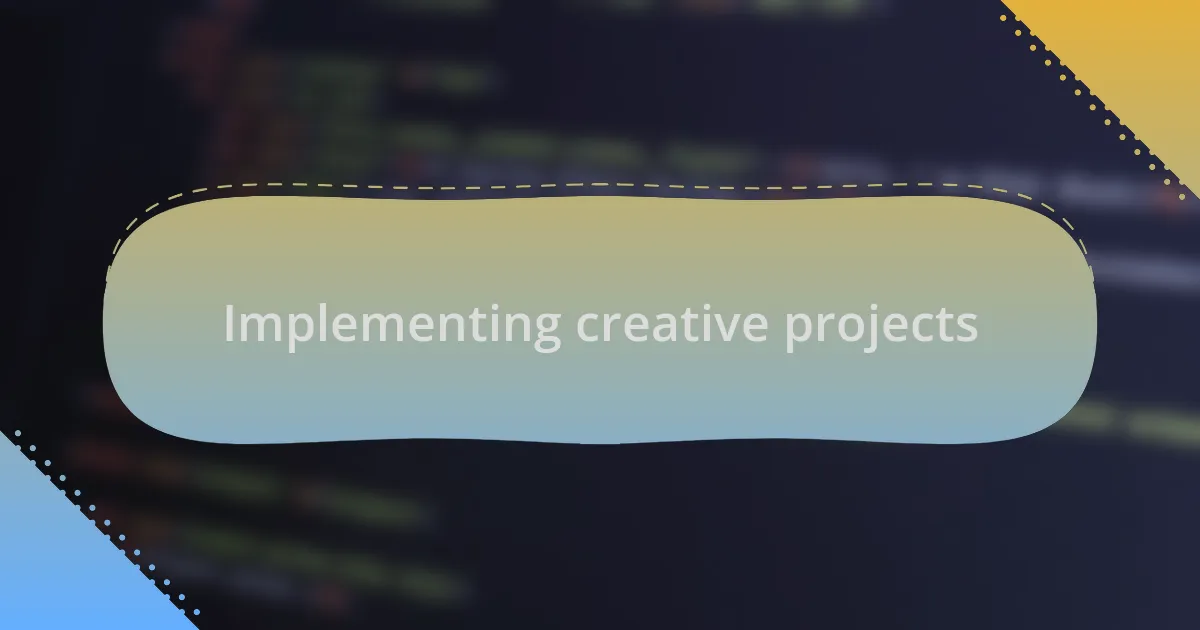
Implementing creative projects
Implementing creative projects is where ideas really begin to take shape. I remember once diving into a side project where I aimed to create a game from scratch. At first, the sheer scope felt overwhelming, but breaking it down into smaller tasks turned it into an exciting challenge. Have you ever taken a big idea and carved it into manageable pieces? It’s liberating to see progress as you check off those tasks, isn’t it?
As I navigated through this project, I made a conscious effort to embrace experimentation. One evening, while I was stuck on a particularly tricky problem, I decided to try an entirely different approach. This shift not only resolved my issue, but it also sparked additional creative features I hadn’t previously considered. What if, instead of feeling defeated when things don’t go as planned, we viewed those moments as opportunities for innovation?
Additionally, I’ve found that documenting the creative process can be incredibly rewarding. Keeping a journal of my thoughts, sketches, and reflections allowed me to map my journey and recognize the evolution of my ideas. It’s like holding a mirror to your creativity—each entry reveals how far you’ve come. Have you thought about how allowing yourself to reflect could open new doors in your projects? It can truly transform the way we approach our work.
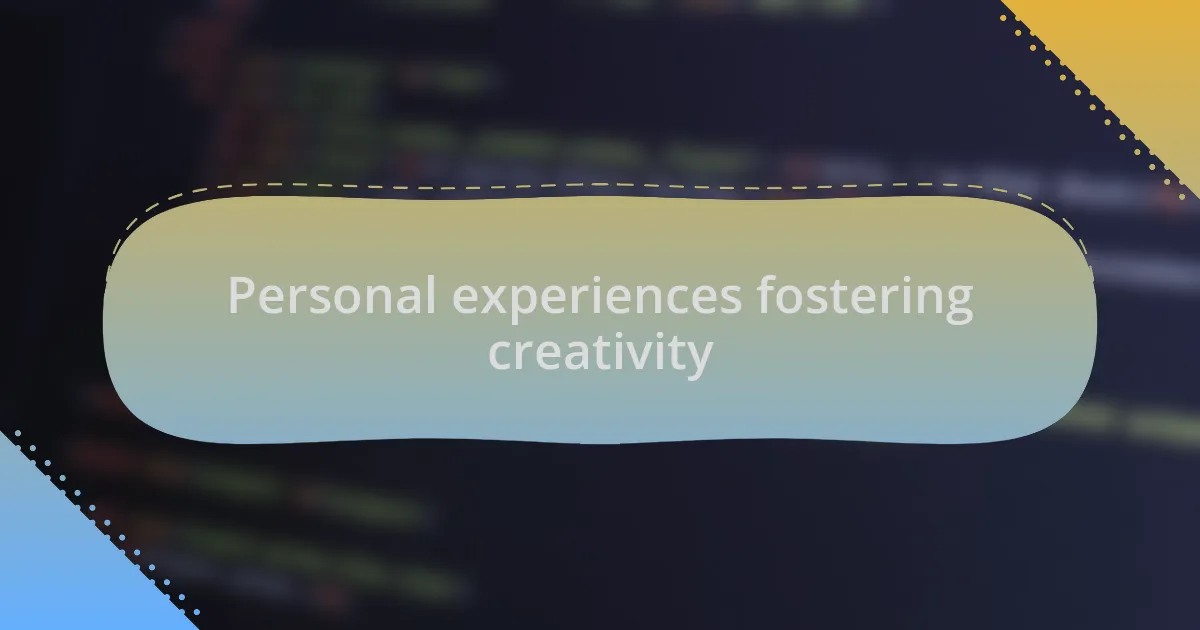
Personal experiences fostering creativity
Fostering creativity often comes from unexpected places. I remember a late-night coding session where I reached a mental block, feeling frustrated and stuck. Instead of pushing through, I stepped away and grabbed my guitar. Playing music allowed my mind to reset and, when I returned to my coding, ideas flowed like they had been waiting for my brain to catch up. Have you ever noticed how a simple change of activity can spark inspiration?
On another occasion, while collaborating with a friend on a project, we decided to adopt a “no bad ideas” policy during brainstorming. This safe space led to some wild and imaginative suggestions that we would have otherwise dismissed. One idea—a quirky art style—ultimately became a signature element of the project. It made me realize how liberating it can be to strip away self-judgment and allow creativity to roam freely. Have you ever held back an idea out of fear? Trust me, letting go can lead to incredible breakthroughs.
Lastly, I’ve seen the power of diverse perspectives in fostering creativity. In one workshop I attended, participants came from various backgrounds, and the discussions were richer because of it. It was eye-opening to witness how someone else’s viewpoint could ignite a new thought process. Have you had the chance to collaborate with individuals outside your usual circles? Embracing diverse ideas not only broadens our horizons, but it also fuels our creative engines, opening us to possibilities we might never have imagined on our own.